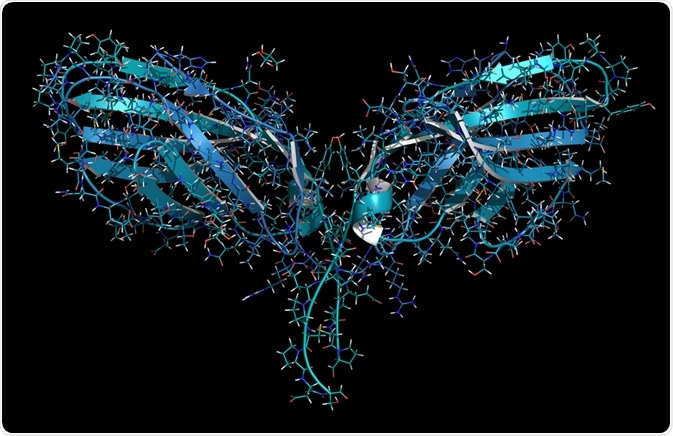Antibodies are vital components of the immune system; fighting infection and disease to protect the body. Investigating the genetic makeup of such proteins is very important in several different applications, including antibody engineering, database banking, function optimization and the discovery of novel antibody clones.
 molekuul_be | Shutterstock
molekuul_be | Shutterstock
Monoclonal antibodies can be engineered and selected for in a method known as the hybridoma technique. Initially, a host animal is introduced to an antigen, leading to the generation of specific B-cells. After a few weeks, splenocytes are removed and merged with myeloma cells.
The fused cells are immortal, and after a few weeks of incubation, they eventually produce antibodies. Once these antibodies are obtained, however, they need to be screened to ensure specificity. This screening process can be carried out by several sequencing techniques, as described below.
Traditional, small-scale sequencing techniques
One of the early methods used to identify the nucleic acid sequence of antibodies was the small-scale method of Sanger sequencing. In Sanger sequencing, sample DNA is split into four vials, containing all four deoxynucleotides and DNA polymerase.
As DNA is transcribed in each vial, modified labeled di-deoxynucleoside triphosphates (ddNTPs) are then added which terminate DNA elongation. Each vial receives a different ddNTP which stops the sequencing on a different nucleotide. The fragments generated can then be separated by electrophoresis which can ultimately be used to identify the sequence of the DNA by the relative location of each band.
This method has been used across many industries, such as antibody research, and has been used to sequence the first entire human genome in the Human Genome Project in 2003. However, this method is limited as it is very slow, requires lots of manual work and is prone to error. Therefore, modern approaches have been developed to enhance the throughput and reliability of sequencing.
Modern, large-scale sequencing techniques
Next-generation sequencing technologies are modern methods of identifying the nucleic acid sequence of DNA. The use of fluorescently labeled dNTPs allows for faster results, sequencing thousands of fragments in parallel. There are four main stages involved:
- Library preparation: The DNA sample is fragmented, and adapters are added to each end.
- Cluster amplification: Fragments are hybridized to the surface of the flow cell and multiplied.
- Sequencing: Reagents are added to the sample, and the sequencing begins. As fluorescently labeled antibodies are incorporated they release emissions of specific wavelengths.
- Analysis: The sequence of the DNA is inferred from the obtained data by bioinformatics software.
De novo peptide sequencing
Alternatively, rather than the nucleic acids being sequenced, de novo peptide sequencing can sequence the amino acid sequence of an antibody. Initially, the sequence is fragmented before undergoing tandem mass spectrometry which identifies a spectrum of mass-to-charge ratios of each fragment. The fragment sequences can then be identified and reconstructed into one total sequence through bioinformatics software which identifies overlapping sequences.
Edman sequencing
Another potential method of identifying the peptide sequence of antibodies is through the Edman sequencing technique. This works by repetitively removing a single amino acid, identifying it, and then cycling back to remove another amino acid. However, this method is very prone to error and is rather slow.
Further Reading